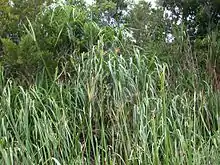Cyperus malaccensis
Cyperus malaccensis or short-leaved Malacca galingale is a species of thin long sedge grass. It is planted in the land between the sea water and fresh water, mainly in Vietnam, and processed in Dongguan. It is also called salt water grass.
| Cyperus malaccensis | |
|---|---|
 | |
| Scientific classification | |
| Kingdom: | Plantae |
| Clade: | Tracheophytes |
| Clade: | Angiosperms |
| Clade: | Monocots |
| Clade: | Commelinids |
| Order: | Poales |
| Family: | Cyperaceae |
| Genus: | Cyperus |
| Species: | C. malaccensis |
| Binomial name | |
| Cyperus malaccensis Lam. 1791[1] | |
| Subspecies | |
| |
| Synonyms | |
| |
It is used in packaging in South China, mainly before the 1980s, for packaging goods. At that time people packaged goods by wrapping them in grass. It was common to use a long loop to tie up the package, to aid carrying with the index finger. For meat, newspaper was used (later waxed paper, which is still used in wrapping herbs and Char siu). Shichitoi was mostly replaced by plastic bags but is still used to package zongzi and Chinese mitten crab. However, liquid in the food may drip out when walking, which led to the use of the plastic bags. There are few people left growing and selling it[2][3]
For packaging dry goods, Cyperus malaccensis can provide a cheap, biodegradable and readily available alternative to plastic bags. On 30 September 2007, Greeners Action,[4] a green student council in Hong Kong campaign the "Days of Salt water grass". In some days from October to February, more than 130 shops in 6 Hong Kong markets will use the grass to tie the fruits and vegetables and will not use the plastic bags.[5]
References
- "World Checklist of Selected Plant Families: Royal Botanic Gardens, Kew". wcsp.science.kew.org. Retrieved 2018-11-19.
- 鹹水草哼夕陽之歌膠袋取代供應商全港剩一家 Archived October 11, 2007, at the Wayback Machine
- 政府建議開徵膠袋稅,令免費膠袋的時代或將畫上句號,取而代之會是「咸魚翻生」的街市鹹水草
- Greeners Action
- 街市鹹水草綁菜倡環保